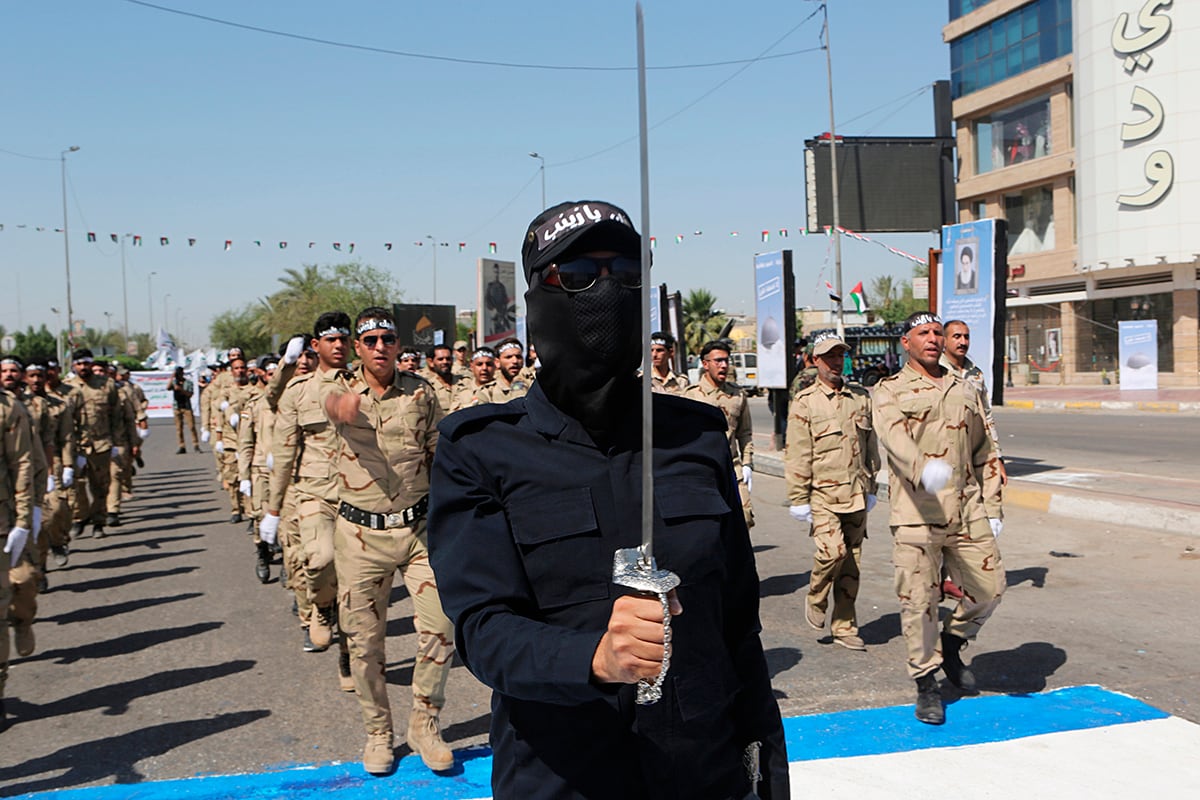U.S. forces struck five Hezbollah targets on Sunday, according to a Pentagon news release, in retaliation for a Friday attack on a Iraqi coalition base that killed one U.S. civilian.
The locations — three in Iraq and two in Syria — included storage facilities and command-and-control centers the Iran-backed group uses to carry out attacks, Pentagon spokesman Jonathan Hoffman said in the release.
“Iran and their [Hezbollah] proxy forces must cease their attacks on U.S. and coalition forces, and respect Iraq’s sovereignty, to prevent additional defensive actions by U.S. forces,” he said.
The strikes came two days after a rocket attack on an Iraqi Security Forces base, which houses coalition forces fighting the anti-ISIS campaign, in Kirkuk. The attack killed one American contractor and wounded several Iraqi troops.
On Saturday, after reports that an Iran-backed militia had launched the assault, Sen. Tom Cotton, R-Ark., tweeted that Iran should “face swift and severe consequences” if true.
The Pentagon said Sunday its strikes specifically targeted an Iranian-backed militia known as Kata’ib Hizbollah.
U.S. officials have identified the Iranian supported militia for a number of attacks over the last couple of months to include the Dec. 3 strike against the al-Asad airbase and the 30-plus rocket strike that slammed a Kirkuk military base on Friday.
While al-Asad is located in Anbar province, Iraq, Kata’ib Hizbollah has an extensive network across the volatile province, according to Phillip Smyth, a research fellow for the Washington Institute and Iran expert.
The Shia militant group has been known to operate in al-Qaim, Abu Kamal and along Route 1 that runs through Anbar province, Smyth told Military Times.
Friday’s attack against the Kirkuk base was at least the 11th rocket attack against U.S. bases and interests in Iraq over the last two months.
A U.S. official previously told Military Times that the attackers, believed to be Iranian-backed militias, have been using more powerful 122 mm rockets.
Friday’s attack on Kirkuk used 107 mm rockets. A source on-base told Military Times that the truck used in the Kirkuk attack had been recovered and included makeshift tubes capable of firing 36 rockets. The source said all but four rockets had been fired.
An armory aboard the Kirkuk base was nearly completely destroyed, the source detailed to Military Times.
The Pentagon’s announcement Sunday that it had struck an Iranian-backed militia is the first public announcement of U.S. military action against the Shia militant group since tensions between Washington and Tehran have escalated following a series of attacks on commercial oil tankers in the Persian Gulf and the September strike against two Saudi Arabian oil fields.
Lawmakers on Capitol Hill have expressed concern that the policy of restraint towards Tehran has diminished the U.S. military’s ability to deter Iranian aggression in the region.
RELATED

“We are in a period of heightened risk with respect to Iran,” Gen. Mark Milley, the Joint Chiefs chairman told lawmakers in December. But the top American commander explained that “restraint in this particular situation is an appropriate response.”
“The ball is in the Iranian court," Milley said. How they [Iran] respond and the size and scope of that response will determine a U.S. answer, he explained to lawmakers.
“Iran should not mistake the United States’ restraint for an unwillingness to respond with decisive military force should our forces or interests be attacked," Secretary of Defense Mark Esper told lawmakers in December.
U.S. officials have warned Iran and its proxies to halt rocket attacks in the country. In mid-December Esper phoned Iraqi Prime Minster Adel Abd al Mahdi and asked for help to stop the rocket attacks.
Iraq has struggled to control the nebulous web of militia groups known as the Popular Mobilization Forces, which rose in the chaos of ISIS’s scourge across Iraq in 2014. Most PMFs are Shia militias with Iranian support.
The government has tried to fold PMFs into Iraqi security forces, but a recent U.S. inspector general report detailed that some militias have defied the Iraqi order.
The Defense Intelligence Agency also said in the IG report that “Iranian-affiliated groups within the PMF are unlikely to change their loyalties because of the new order.”
Secretary of State Mike Pompeo warned Iran and its leaders in December of a “decisive U.S. response” if the regime or its militias harm American troops or allies in the region.
Other U.S. lawmakers have questioned whether Iran’s aggressive behavior is a symptom of the failure of President Donald Trump’s failed maximum pressure campaign to rein in Iran’s malign activity in the region.
Iran is “much closer” to a nuclear weapon and “regional aggression picked up," Massachusetts Rep. Seth Moulton told Esper during a December hearing. The “administration’s strategy is failing."
Analysts and national security experts have warned the Trump administration that Iran would likely strike against U.S. interests in the region through proxy and militia forces.
Iran has an extensive network of militias that stretch from Tehran to Yemen and Syria. Attacks carried out by these groups complicate efforts to assign blame to Iran.
Iran often uses asymmetrical force just below the threshold of major armed conflict across the Middle East to confront the U.S.
America’s strikes Sunday against the Iranian-backed militia may be a sign of a heated proxy conflict brewing between Iran and the U.S. in the Middle East.
Meghann Myers is the Pentagon bureau chief at Military Times. She covers operations, policy, personnel, leadership and other issues affecting service members.
Shawn Snow is the senior reporter for Marine Corps Times and a Marine Corps veteran.




